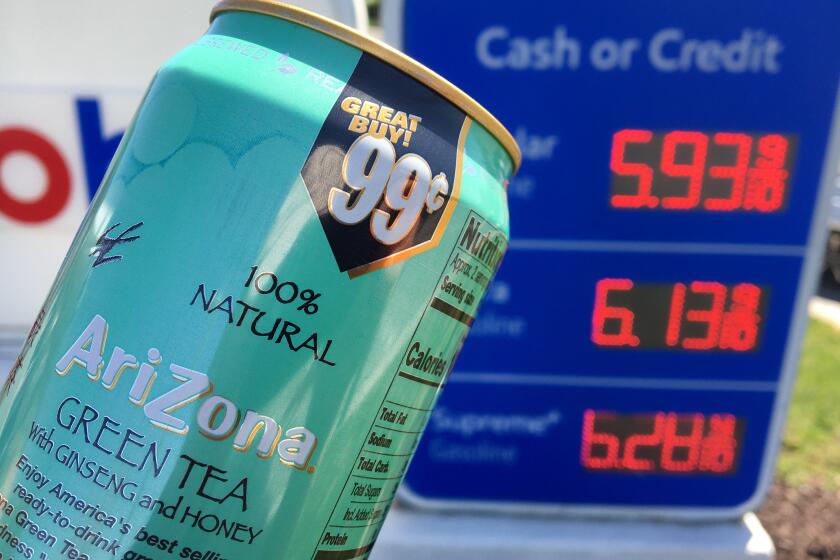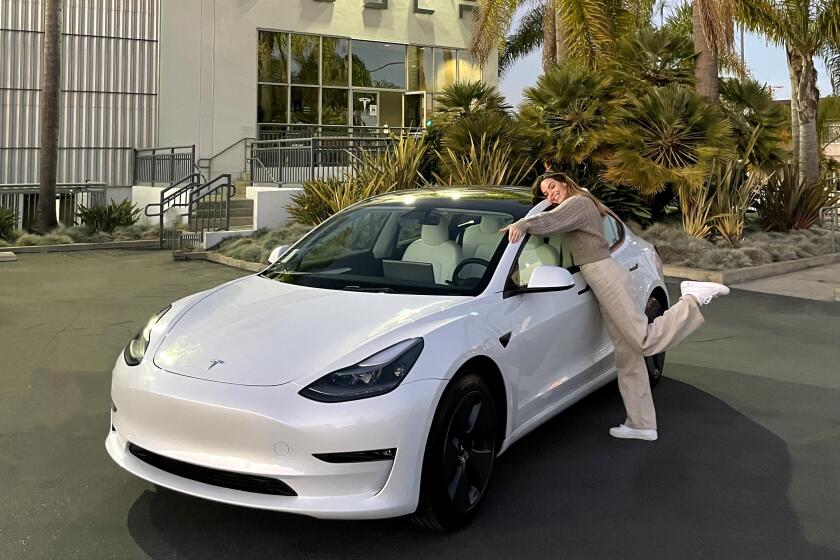U.S. consumers hang in there despite a bigger inflation bite

- Share via
It’s not all doom and gloom for the U.S. economy.
Thursday’s reports of retail sales and consumer sentiment offered a glimmer of optimism that Americans aren’t ready to pull back on spending en masse in the face of decades-high inflation.
Granted, the 0.5% rise in March sales was dwarfed by an even bigger increase in inflation that shows real spending is softening after a stronger start to the year. But price pressures are expected to simmer down a bit in coming months, and the University of Michigan’s sentiment survey showed households grew more upbeat about their financial situations.
These latest developments are a hopeful sign for the economy, even as more economists have raised their odds of recession as the Federal Reserve scrambles to fight off inflation with more aggressive monetary policy.
“Inflation is not going away, but it will likely stop getting worse and that means less of a headwind for spending,” Wells Fargo & Co. economists Tim Quinlan and Shannon Seery said in a note.
Consumer spending is by far the largest contributor to economic activity, and economists are keenly looking for any sign that the financial health of households is weakening. However, Bank of America Institute data showed strong growth in credit card spending continued into April, especially among lower-income households.
Tall cans of AriZona iced tea have cost 99 cents since 1992. The family behind the company says it’s committed to that price even as the prices of aluminum and corn syrup climb higher.
“In short, the labor market and the state of consumers’ finances are good reasons to treat the doomsayers with caution,” David Tinsley, director of the Bank of America Institute, said in a note Wednesday.
Retail sales last month were helped by a surge in gas station receipts that were boosted by higher per-gallon costs for fuel. But some discretionary categories such as apparel and restaurant spending also showed growth, counter to expectations that inflation would slow such purchases.
“In some discretionary categories, such as apparel and restaurant spending, the rise in nominal sales outstripped inflation and suggested that the easing in pandemic-related restrictions is helping consumer spending, while in other components it was clear that inflation played a large role in boosting spending,” Omair Sharif, founder of Inflation Insights, said in a note.
A strong labor market is supporting spending and sentiment. Applications for unemployment insurance increased slightly to 185,000 last week, but it’s still “a low level that suggests imminent recession fears are exaggerated,” Bloomberg economist Eliza Winger said in a note. The unemployment rate is one of the lowest in the last 50 years, and wages are rising, though not as fast as inflation.
In the Michigan survey, the overall sentiment gauge jumped in March and exceeded all estimates. Respondents also said they anticipate continued wage gains. Perhaps even more hopeful is that inflation expectations held steady, a good sign that Americans don’t see it worsening much more.
High gas prices are making life difficult for many drivers. But some people aren’t bothered, mainly because they switched to other modes of transportation.
That should offer some comfort to the Fed, which is pivoting to a more aggressive policy stance to combat price increases. Some economists fear the Fed may go too far, and if combined with a broad retrenchment in consumer spending, the economy could tip into recession.
To be sure, there are valid reasons for concern. Consumer prices rose 8.5% in March from a year earlier, the most since 1981, and producer prices jumped the most in records dating to 2010. When adjusted for inflation, retail sales actually declined 1.6% in the month, Sharif said.
Earnings reports this week also showed merchants such as Bed Bath & Beyond Co. and grocer Albertsons Inc. are seeing softer demand due to inflation. But the data released Thursday offer some evidence that demand destruction won’t be as bad as feared.
JPMorgan Chase & Co. economists on Thursday boosted their tracking estimate for first-quarter real gross domestic product, due in part to a sizable upward revision to February retail sales. Still, they’re calling for only a 0.9% annualized rate of growth.
“Of course it is hard to have a precise story to explain all of the monthly changes across the retail sales report,” JPMorgan’s Daniel Silver said in a note. “But it does look clear that price increases have boosted nominal spending lately while real spending has weakened.”
More to Read
Inside the business of entertainment
The Wide Shot brings you news, analysis and insights on everything from streaming wars to production — and what it all means for the future.
You may occasionally receive promotional content from the Los Angeles Times.











